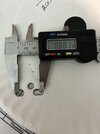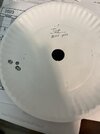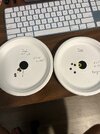LocoGringo
Member
The Rifle:
Bergara B14 Ridge, 7mm-08, 22" factory barrel
Tract Toric 4-20x50
Banish 30 suppressor in 7" configuration
The Load:
Hornady 139 grain SPBT
Remington brass
42 grains Varget
CCI lrp
MV measured at 2700 fps on the dot
Shooting off of a front rest and rear bag, I wanted to get some chronograph numbers for the load with the new suppressor and test the ballistics calculator results with actual distance shooting at 200 yards. I shot 2 5-shot groups at 100 yards and the groups were 1.110" and .872" respectively. I'm relatively happy with those results as this is going to be a deer hunting rifle. I got the numbers from the chronograph, went on to the Hornady ballistics calculator website, plugged them in and got the drop for the scope at 200 yards. I shot 1 5-shot group at 200 yards. This was my first time trying 200 yards for this rifle and the group measured .881". There was a light, consistent breeze, but nothing that I thought strong enough to push the bullet during flight. Well, I had to be wrong about that because while the groups at 100 were about an inch to the left of bullseye, the group at 200 was 3-3.5 inches to the left of bullseye.
Same shooter, same ammo, same day, same conditions. I understand it's a small sample size, but how does the gun (or shooter) go from 1 MOA at 100 to 1/2 MOA at 200? Oh, just so I'm clear, I'm NOT complaining, but puzzled.
Bergara B14 Ridge, 7mm-08, 22" factory barrel
Tract Toric 4-20x50
Banish 30 suppressor in 7" configuration
The Load:
Hornady 139 grain SPBT
Remington brass
42 grains Varget
CCI lrp
MV measured at 2700 fps on the dot
Shooting off of a front rest and rear bag, I wanted to get some chronograph numbers for the load with the new suppressor and test the ballistics calculator results with actual distance shooting at 200 yards. I shot 2 5-shot groups at 100 yards and the groups were 1.110" and .872" respectively. I'm relatively happy with those results as this is going to be a deer hunting rifle. I got the numbers from the chronograph, went on to the Hornady ballistics calculator website, plugged them in and got the drop for the scope at 200 yards. I shot 1 5-shot group at 200 yards. This was my first time trying 200 yards for this rifle and the group measured .881". There was a light, consistent breeze, but nothing that I thought strong enough to push the bullet during flight. Well, I had to be wrong about that because while the groups at 100 were about an inch to the left of bullseye, the group at 200 was 3-3.5 inches to the left of bullseye.
Same shooter, same ammo, same day, same conditions. I understand it's a small sample size, but how does the gun (or shooter) go from 1 MOA at 100 to 1/2 MOA at 200? Oh, just so I'm clear, I'm NOT complaining, but puzzled.
Last edited:




